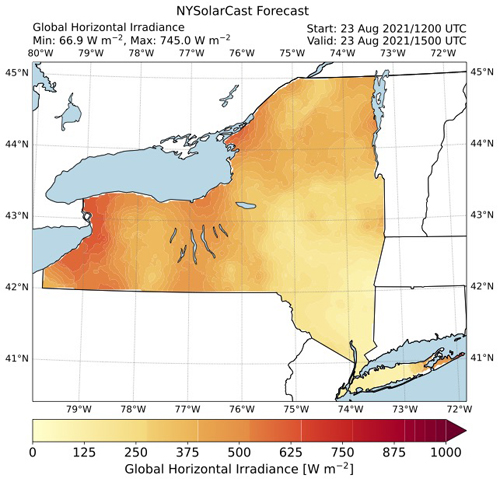NCAR develops advanced solar energy forecasting system
NYSolarCast could help New York save costs, meet renewable energy goals
May 30, 2023 - by David Hosansky
May 30, 2023 - by David Hosansky
The National Center for Atmospheric Research (NCAR) has successfully developed an advanced solar energy forecasting system for New York that offers the potential to help the state achieve its renewable energy goals while saving millions of dollars for ratepayers.
The open-source system, called NYSolarCast, draws on weather forecasts, observations of atmosphere conditions, and machine learning techniques to generate accurate hours- and day-ahead predictions of solar irradiance and resulting power generation. These predictions, issued every 15 minutes for a three-kilometer grid covering all of New York State, can be used to forecast solar power generation for both major solar farms and rooftop solar panels.

In addition to showing promising results for New York, the technology can be applied elsewhere in the United States and other locations around the globe.
"This system is applicable worldwide,” said NCAR scientist Jared Lee, the lead developer. “It is highly configurable and customizable, so it can deliver forecasts at any desired time interval over any forecast region that a utility needs.”
The predictions for New York proved highly accurate. Over a one-year validation period, NYSolarCast’s forecasts consistently came within about 10% of the actual amount of power generated. Encouragingly, the over-forecasts and under-forecasts were nearly balanced.
The development of NYSolarCast was part of a larger, multiyear study to help New York’s growing solar industry deploy weather forecasting to better anticipate power generation and improve the reliability of its electric grid. More accurate forecasts are important for the state to meet its goals of 70% electrical generation from renewable sources by 2030 and a zero-emission electricity sector by 2040.
The study was funded by the New York Power Authority and the New York State Energy Research and Development Authority. It was co-managed by EPRI, an independent, nonprofit energy R&D institute. Other partners included Brookhaven National Lab and the State University of New York at Albany. Advisors included the New York Independent System Operator (NYISO) and Central Hudson, a New York distribution utility.
Successfully forecasting solar irradiance is critical for expanded solar energy production. If an electric utility powers down a coal or natural gas facility in anticipation of energy from the Sun or another renewable source, those plants may not be able to power up fast enough should the amount of sunshine be insufficient. The only option in such a scenario is to buy energy on the spot market, which can be very costly.
NCAR had previously developed a wind energy forecasting system that saves Xcel Energy ratepayers millions of dollars yearly.
When it came to developing NYSolarCast, Lee and his colleagues faced substantial challenges. New York is a climatologically diverse state, with the snowbelt along the Great Lakes and high peaks of the Adirondacks generating far different atmospheric conditions than the coastal region of Long Island. In addition, their models had to capture clouds with considerable precision because different clouds have varying impacts on solar irradiance. A bank of low-lying stratus clouds, for example, will block incoming sunshine, whereas puffy cumulus clouds can reflect irradiance off their sides, thereby leading to temporarily higher solar irradiance at the surface and more solar energy output than would occur during a clear blue sky.
To develop a useful system, Lee and his colleagues drew on two years of weather observations from the New York State Mesonet, a statewide network of 126 weather stations. They also analyzed power production data from selected solar installations. This historical information enabled them to train machine learning models to correlate weather conditions with power output.
They then used two advanced weather models: a specialized version of the NCAR-based Weather Research and Forecasting model tuned for solar applications (WRF-Solar) and the NOAA High-Resolution Rapid Refresh (HRRR) model. The models generated fine-scale weather forecasts several hours to a day in advance, which the machine learning model translated into predicted solar output.
“We’re very pleased that the NYSolarCast system provides accurate forecasting of both utility-scale solar farms and rooftop solar panels,” Lee said. “Continually improving the accuracy of forecasts is vital for the solar industry, which needs to ensure the reliable delivery of renewable energy and improve the overall performance of the electric grid as more solar energy generation is built.”